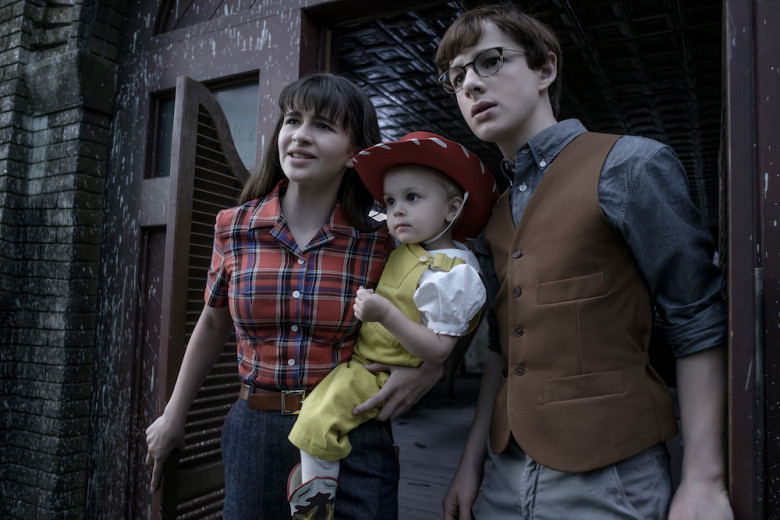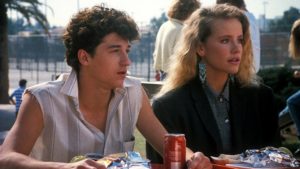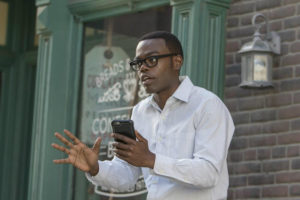Tune in or look away
Season two of “Unfortunate Events” dazzles and disappoints
The Baudelaire children— Violet, Klaus, and Sunny— in the episode “The Vile Village.” Despite some questionable decisions by the writers, the series is best when it focuses on what viewers care most about: the dire straits of the Baudelaires and capturing the tone of the beloved books.
April 21, 2018
Sometimes, when you find yourself on the brink of making a risky decision — like whether or not to leave home, invest in cryptocurrencies, or become a rogue detective working for a secret organization — a friend will try to discourage you by saying “anything that can go wrong, will go wrong.”
Your friend is providing you an aphorism, a word which here means a small piece of advice unwisely applied to nearly every situation, and in most cases he or she would be wrong.
Even if on your plane ride out of town, you die in a mysterious crash-landing and your body is never found, it’s unlikely that before your untimely demise that the stewardess would forget to bring you some of the packaged snacks you love so dearly.
And even if you lose all your money to bitcoin, maybe in your poverty you’ll be taken in by an ex-lover and reignite a long, lost romance.
And even if you become a rogue detective, it’s doubtful that you wouldn’t discover at least one long-held secret that would make having the authorities after you completely worth it.
The aphorism “anything that can go wrong, will go wrong” doesn’t even apply to the Baudelaire orphans during their treacherous times in “A Series of Unfortunate Events.” Sometimes they meet a fine guardian, or happen upon something that brings them some vestige of happiness. In other words, things occasionally go right.
And so it’s the same for television: if someone were to declare that they were adapting the story of the Baudelaires into a Netflix original series, their friend might say “watch out, anything that can go wrong, will go wrong.” And that’s simply not correct, because like anything, the show is something of a mixed bag. Season two of the series is no exception.
The Pros
Maintains season one’s immense respect for the novels
Aside from one major exception that will be discussed later, season two maintained the narrative structure of the books. The series rides the line between producing an effective visual product and minimizing removal of important details included in the written word.
All the expected characters show up, and are just as you remember them (kudos going to the abhorrent Vice Principal Nero of Prufrock Preparatory School and the adorable Hector of the Village of Fowl Devotees).
Oftentimes exact dialogue from the books are repeated. This is true even in the case of Sunny Baudelaire, whose exceedingly clever toddler-level speech is presented via subtitles. And where there is an altering of details, it makes perfect sense, and enhances the visual medium.
For example, in “The Hostile Hospital,” Klaus and Sunny must fashion a disguise. In the books, both children wear medical coats, fooling those around them. This is harder to wrap your brain around on TV, so instead Klaus fashions a harness and conceals his sister under his medical coat. It’s seamless, and a whole lot more fun.
Costume and set design
“A Series of Unfortunate Events” really goes all out in this department. There are certain things that just can’t be displayed in the novels, and it’s a treat to see the world of the series come to life on screen.
The Baudelaires are serving looks. Whether it’s school uniforms courtesy of Prufrock Preparatory School or pinstripe suits gifted by Esme Squalor, this kids’ clothes not only inspire an immediate “Aww!” but effectively set the tone for each episode.
The various places the kids are forced to visit on their misadventures really shine, too. 667 Dark Avenue is the home of the Squalors, Esme and Jerome, illustrious (and perhaps nefarious) city-slickers who take the Baudelaires in. The penthouse apartment is striking and the most standout example of set design throughout season two.
On the whole, however, the sets perfectly match the tone of the series. While intricate, they don’t distract from whatever dire strait the Baudelaires are put into. The sets complement the story.
Neil Patrick Harris
When he’s on, he’s on. Harris shines the most when he’s the dismissive, truly evil Olaf. Harris impeccably switches back and forth between Olaf and his various disguises, showing the villain bleeding through the facade, sometimes involuntarily.
Another dimension to Olaf’s character is his distaste for his own girlfriend Esme Squalor, and Harris portrays this flawlessly. Every off-hand comment he delivers, not only in this relationship but toward all characters in the series, adds something less whimsical and more truly scary to Count Olaf.
The Cons
Neil Patrick Harris
But he’s still not the perfect Olaf. The actor can be a little too “himself” for the role, and it oftentimes feels like you’re just watching Harris talk intensely into the camera rather than seeing Olaf hatch a scheme.
And he’s gotten more theatrical this season, including a full on musical number at the end of “The Ersatz Elevator: Part One.” It’s completely tone deaf to the vibe of the show, and is the only solidly cringeworthy moment of the season. (No hard feelings, though, since in that same episode we got to see Cafe Salmonella, the most iconic establishment from the entire series, up close and personal).
Adults over-saturating the kids’ story
The focus shifts a bit this season, and it’s not to what fans most love about “A Series of Unfortunate Events.” More scenes focus solely on Count Olaf and his troupe, rather than their interactions with the Baudelaires. Compounding this is the introduction of Esme Squalor, who first appears as the city’s sixth most important financial advisor, maniacal girlfriend of Count Olaf, and the Baudelaire’s newest guardian in “The Ersatz Elevator.”
This makes a lot of sense, due to another problem that season two grappled with more than season one: the run time. The first season had the benefit of using this extra time to get to know the Baudelaires and allow audiences to become acquainted with their situation. But by season two, everyone gets it. It feels like you could shave off a solid ten to fifteen minutes of each episode and still do the source material justice. This shouldn’t be a surprise, since an adept reader can probably tear through any of the “A Series of Unfortunate Events” books in an hour. Netflix set aside more than twice that for each book, and that extra time was mostly filled with
Olivia Caliban
And this last one is sort of odd, because this librarian-turned-heroine was certainly someone we want to love. She has great eyebrows, an adorable lisp, and most definitely qualifies as a “noble, well-read person.” It’s an extension of the problem the series had with needing to fill up time, and spending too much of that time on adult characters, and also represents one of the only major changes from the novels. From a certain angle, her inclusion may seem to be a home-run, but the intended impact doesn’t quite translate to viewers.
In the novels, Madame Lulu is the alias of Olivia Caliban, and the character only appears in the ninth installment, “The Carnivorous Carnival.” Madame Lulu is morally ambiguous, having historically supported both the honorable organization V.F.D. and the repugnant Count Olaf.
In contrast, the television show introduces her earlier as the librarian at Prufrock Preparatory School and then the companion of Jacques Snicket, and as such she’s transformed from her complex beginnings to something that’s much more feel-good. The show seems to venture this direction in order to provide more answers about the over-arching mystery, even using Olivia as a means to reveal to the children what the initials “V.F.D.” mean (something the literary Baudelaires are still unaware of).
And while most of her scenes were enjoyable, it’s not clear what her purpose was. Furthermore, it feels slightly dishonest to the books. Not because any major change is necessarily a bad one, but because her inclusion breaks up the narrative style so important in the books — we only see what the Baudelaires see.
Some exceptions to this rule would be completely alright, especially if they’re used to advance the story and create suspense, but in Caliban’s case a precise reason isn’t clear. When we know far more than the Baudelaires do about the mystery they’re trying to uncover, it stops being solely their story.
But the cons mentioned here say a lot about “A Series of Unfortunate Events.” These are fairly minimal things. The show isn’t going to echo the spirit of the books on every beat, and your lead actor isn’t going to be perfect for all fifty minutes. What’s important is that even though the series may not have spent every moment on the Baudelaire children, viewers are still invested in where they’re going, and are surely ready for the big finale in season three.








